In just two hours, you can create a simple 14-dinner meal plan by focusing on core meals, batch cooking, and versatile ingredients. Pick quick-reheat recipes like pasta, stir-fries, or tacos, and add small variations with herbs or sides to keep things fresh. Organize your shopping around pantry staples and freezer-friendly ingredients for efficiency. Continuing will reveal practical tips to streamline your process and keep your meals interesting and sustainable.
Key Takeaways
- Focus on 7-10 core, quick-to-prepare meals with small variations for a predictable, rotating 14-day dinner plan.
- Batch shop and prep ingredients in bulk, prioritizing versatile staples like chicken, grains, and seasonal produce.
- Prepare proteins, grains, and vegetables separately for flexible, quick assembly during the week.
- Freeze meal components in labeled, portioned containers to streamline last-minute dinner choices.
- Use simple recipe templates with interchangeable ingredients to minimize planning and cooking time within the 2-hour window.
Choosing Core Meals for Simplicity and Variety
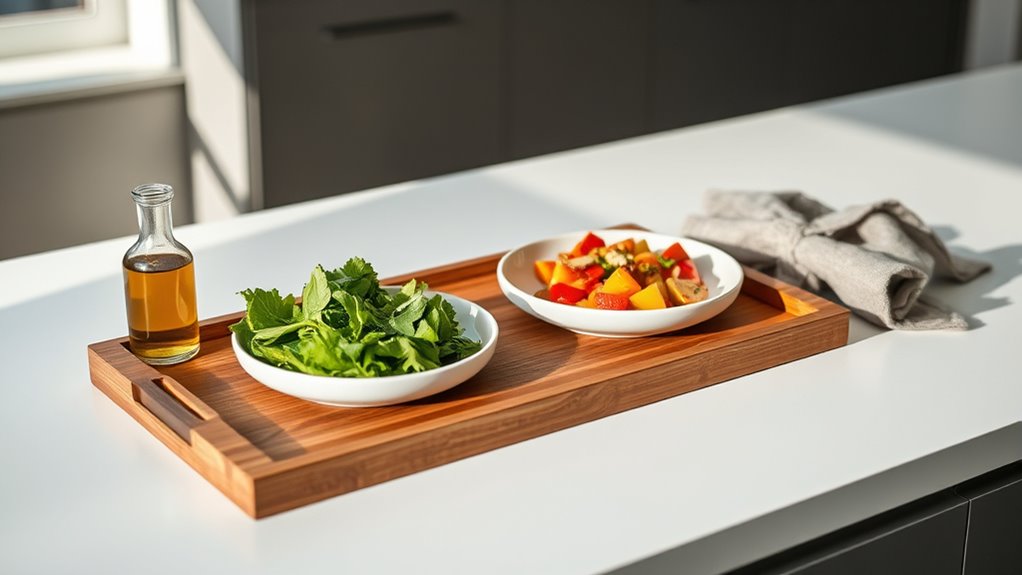
Choosing core meals is a smart way to simplify your weekly planning while still offering variety. These tried-and-true recipes are quick to prepare, often taking less than 30 minutes or needing minimal prep if slow-cooked. They use familiar ingredients, making it easy to rotate them in your meal schedule without hassle. Core meals can be batch-cooked and frozen, saving you time during busy weeknights. They also help cut down on grocery costs by relying on common ingredients, and their flexibility allows you to adapt with different sides or toppings. Family favorites like pasta, tacos, stir-fries, and grilled dishes serve as a reliable foundation. By focusing on core meals, you reduce decision fatigue and make weeknight dinners more manageable and enjoyable for everyone. This approach aligns with the concept of minimalism by streamlining your meal choices.
Creating a Two-Week Rotation to Minimize Decision Fatigue
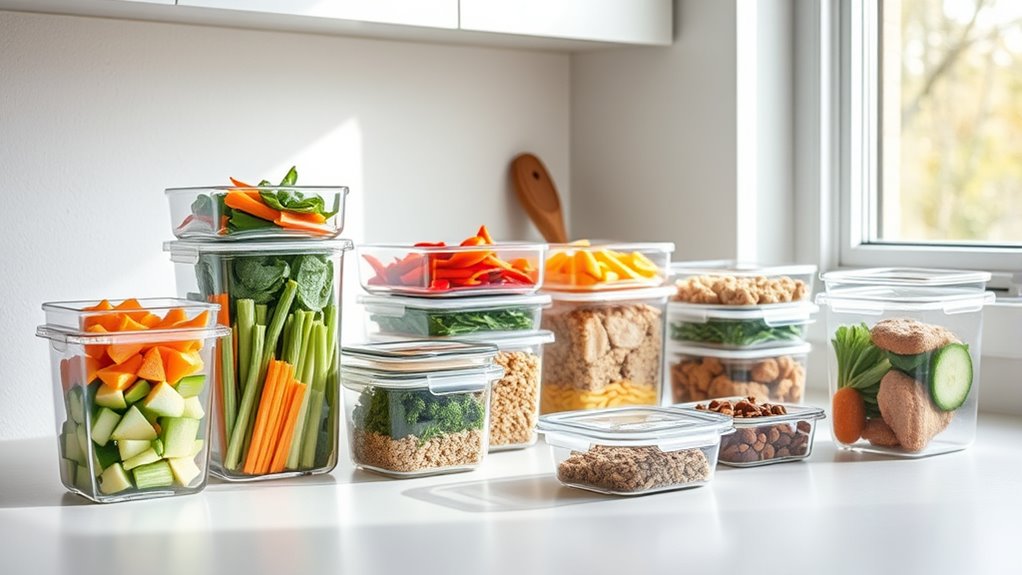
Creating a two-week meal rotation keeps your planning simple and predictable, so you spend less time deciding what to cook. By repeating core meals, you reduce decision fatigue, while making small tweaks keeps your menu interesting. This balance helps you stay consistent without feeling stuck. Consistent adherence to your rotation further enhances meal planning effectiveness and reduces stress. Incorporating strategies from well-being tips can also support your overall meal planning routine.
Simplify With Repeat Meals
Implementing a two-week repeat meal rotation simplifies your meal planning by reducing daily decision-making and streamlining your grocery shopping. With predictable ingredient lists, you spend less time shopping and waste less food. Repeating balanced meals helps you stick to your dietary goals and ensures consistent nutrition. It also saves time by reusing familiar recipes, making meal prep quicker and easier. By planning a 14-day cycle that repeats, you create a reliable routine that minimizes stress and decision fatigue. Incorporate interchangeable components like different proteins or vegetables to add slight variety without overcomplicating your plans. Using leftovers strategically reduces waste and prep time. Overall, a repeat meal rotation supports healthier eating habits, better budget control, and a more manageable, stress-free approach to dinner planning. Additionally, implementing a rotation can help coordinate with meal rotation strategies in senior living communities, ensuring residents receive variety and balanced nutrition with minimal effort. Incorporating meal planning techniques that emphasize simplicity and consistency makes it easier to maintain this routine over time.
Vary With Small Changes
To keep your two-week meal rotation engaging without adding complexity, incorporate small changes that subtly vary your dishes. Use seasonal produce to maximize freshness, flavor, and cost savings. Rotate your menus by season, focusing on different vegetables, fruits, and proteins, which also boosts nutritional diversity. Adjust ingredients or preparation methods slightly—like changing spices or swapping a side—to introduce variety without overhauling your plan. Implement themed nights, such as “Taco Tuesday” or “Meatless Monday,” to simplify choices while keeping meals interesting. Regularly review and tweak your rotation based on leftovers, sales, or new preferences. Incorporating nutritional diversity can help ensure your diet remains balanced and vibrant. Meal planning systems can be customized to suit your routine, helping prevent meal fatigue, refine your cooking skills, and maintain variety, all while keeping planning straightforward and efficient.
Selecting Flexible Dinners to Accommodate Dining Out and Skips
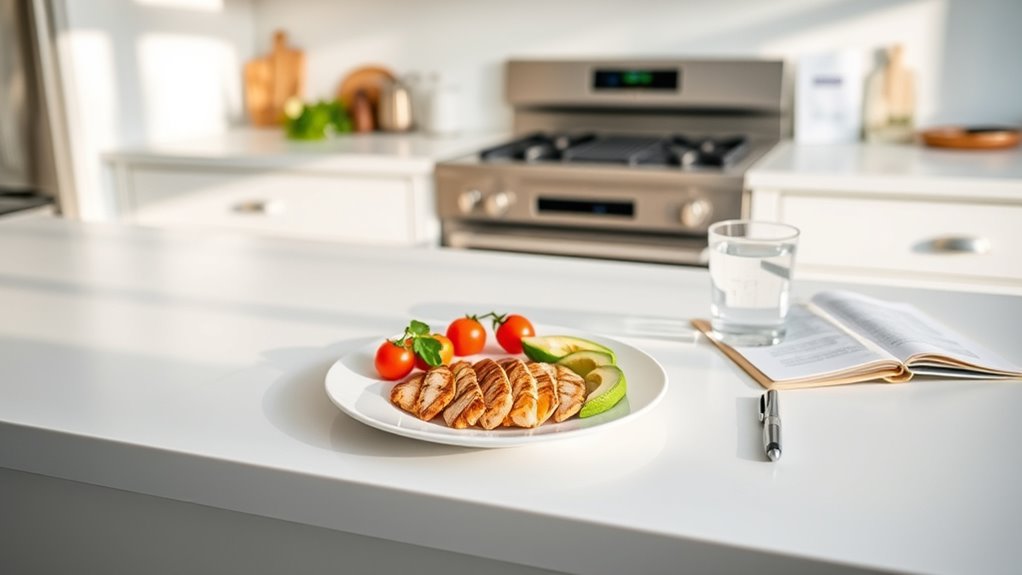
Flexibility in dinner planning is essential when balancing busy schedules, dining out, and unpredictable skips. To adapt, choose dinners that can easily be modified or skipped without hassle. Incorporate versatile ingredients and simple recipes that can be prepared quickly or substituted with takeout. Use planning tools to adjust meals based on dining out frequency or last-minute changes. Consider leftovers as a backup or ingredient for future meals. Here’s a quick guide:
| Meal Type | Flexible Ingredient | Adjustments |
|---|---|---|
| Pasta | Whole-grain noodles | Swap with takeout or skip |
| Stir-fry | Frozen vegetables | Replace with fresh or skip |
| Salad | Pre-washed greens | Add protein or skip |
| Soup | Canned beans | Serve with bread or skip |
This approach guarantees your dinners stay adaptable, reducing stress and waste. Additionally, balancing cost, time, and taste ensures that flexible meal planning remains sustainable and enjoyable for your family. Being aware of home cooking techniques can also help you modify recipes more easily when plans change.
Incorporating Pantry Staples for Quick Meal Assembly
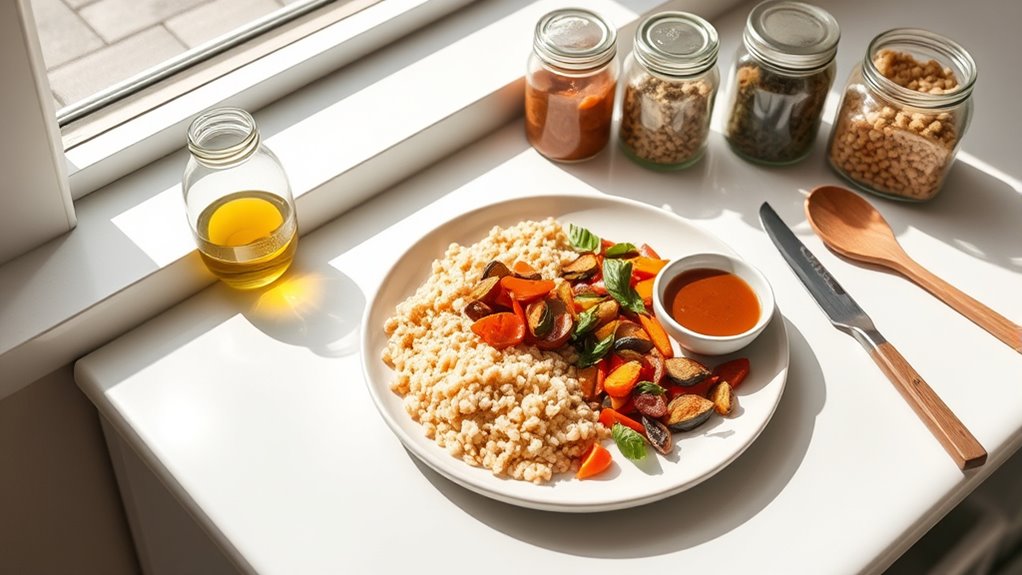
Incorporating pantry staples into your meal routines allows you to whip up quick, versatile dishes with minimal effort. With grains like rice, pasta, or quinoa on hand, you can easily create hearty bases for any meal. Canned beans, tomatoes, and corn enable fast additions that boost flavor and nutrition without extra prep. Using condiments like olive oil, soy sauce, or jarred sauces can quickly elevate your dishes, saving time on flavor-building. Spices and dried herbs such as garlic powder, paprika, and oregano add variety effortlessly. Shelf-stable proteins like canned tuna or chicken provide quick protein options. Organized pantry storage by category and frequency of use helps streamline cooking and reduces search time. By pre-measuring ingredients, combining canned goods with grains, and utilizing stored sauces, you streamline your cooking process. This approach minimizes prep time, maximizes flexibility, and keeps your meals simple yet flavorful.
Batch Cooking and Freezing for Time Savings
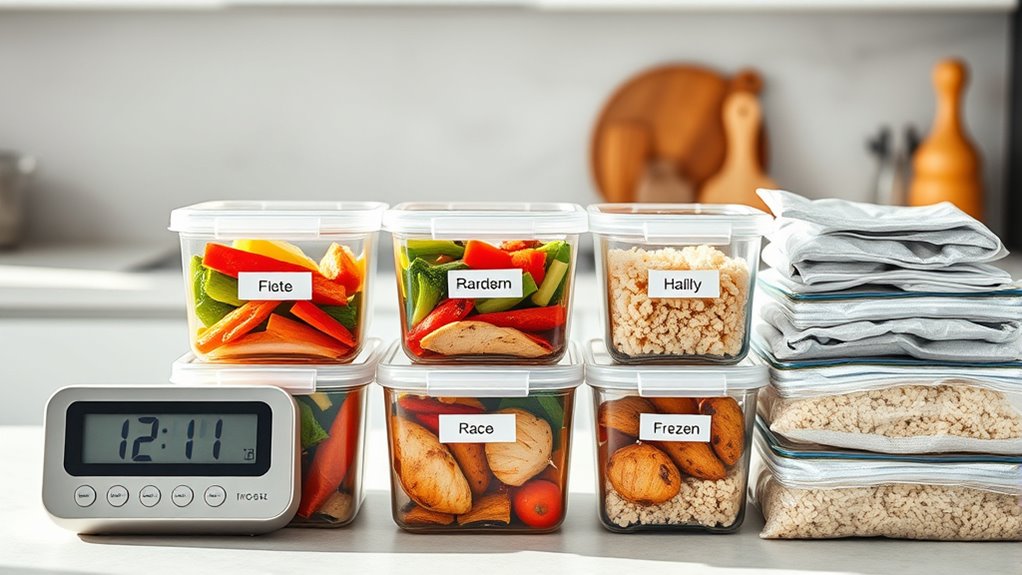
Batch cooking saves you time and effort by preparing large quantities of meals at once, so you can quickly assemble dinners on busy days. This approach reduces daily cooking tasks and lets you reheat pre-made meals, saving valuable time. It also lowers energy costs by cooking multiple dishes simultaneously. Freezing meals in individual portions helps control your intake and minimizes waste, giving you flexibility for future meals. You can freeze grains like rice or quinoa, proteins such as shredded chicken or ground beef, and vegetables, making them easy to incorporate into quick dinners. Proper labeling and organization prevent confusion and spoilage. By maintaining a freezer inventory, you’ll know what’s available, reducing stress and ensuring nutritious, homemade meals are always ready to go when you need them. Utilizing seasonal produce can also enhance flavor and nutritional value while maximizing savings.
Streamlining Ingredient Overlaps to Reduce Waste
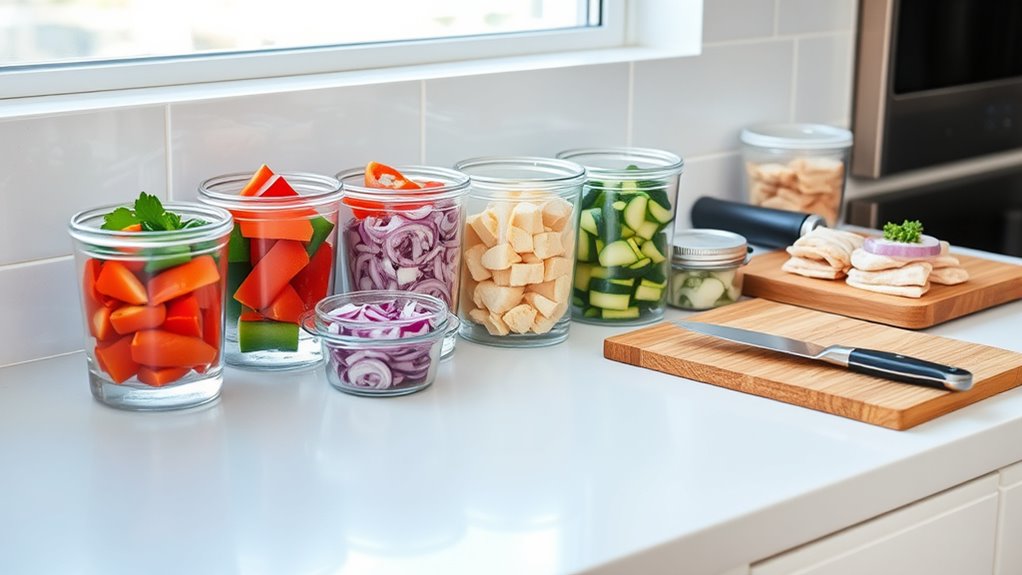
You can cut down on food waste by shopping for ingredients in bulk and planning meals that use overlapping items. When you prepare multiple dishes with common ingredients, you make the most of what you buy and avoid leftovers going bad. By organizing your meal prep around these overlaps, you’ll save time, money, and reduce waste effortlessly. Incorporating meal planning strategies helps ensure that perishable foods are used efficiently and minimizes spoilage. Additionally, understanding food safety guidelines can help prevent spoilage and ensure leftovers are consumed safely.
Batch Ingredient Shopping
Have you ever wondered how to save money and reduce food waste simultaneously? Batch ingredient shopping makes this possible by streamlining your process. Here’s how:
- Buy in bulk to use ingredients before they spoil, lowering waste and costs.
- Identify overlapping ingredients across meals to create efficient shopping lists.
- Visit wholesale stores for bulk options, maximizing savings on essentials.
- Plan meals ahead to prevent impulse buys and ensure ingredients are fully utilized.
- Leverage meal planning strategies that incorporate the principles of holistic well-being, promoting balanced consumption and minimizing excess.
Overlap Meal Prep
Streamlining meal prep by focusing on ingredient overlaps helps maximize efficiency and cut down on waste. Choose a core set of versatile ingredients like bell peppers, spinach, chicken, quinoa, and kale that work across multiple dinners. Pick items with similar cooking times or textures to simplify batch prepping. Use pantry staples, spices, and sauces to add flavor variety without extra shopping. Prepare ingredients separately—proteins, grains, vegetables—to allow flexible combinations during the week. Change up sauces and seasonings to create distinct meals from the same ingredients. Incorporate different cooking methods like roasting or sautéing for variety. Properly store prepped items, especially freezing proteins in meal-sized portions, to extend freshness. Batch cooking and organized storage also help reduce time spent on daily meal assembly, making weeknight dinners more manageable. Employing smart kitchen appliances like automatic refrigerators and intelligent ovens can further streamline your meal prep process. This approach minimizes excess purchases and reduces spoilage, helping you enjoy fresh, diverse dinners with less waste.
Planning Breakfast, Snacks, and Lunch Options for Balance

Achieving balance in breakfast, snacks, and lunch starts with selecting nutrient-dense options that are easy to prepare and portable. Focus on foods that fuel your day without added complexity. Here are four ideas:
- Prepare overnight oats the night before in jars for a fiber-rich, grab-and-go meal.
- Keep hard-boiled eggs or egg muffins handy for quick, protein-packed options.
- Bake muffins with nutritious ingredients like zucchini or pumpkin, which freeze well and boost vitamins.
- Make chia seed pudding topped with fruits and granola for a fiber, healthy fats, and protein combo. Consistently rotating these options can help maintain variety and prevent meal fatigue. These choices help maintain energy and satiety throughout your day, all while keeping prep minimal and portable. Incorporating durable, high-quality ingredients into your meal prep can further ensure safety and freshness over time.
Utilizing Meal Planning Templates for Organization

Using meal planning templates can substantially boost your organization by providing a clear framework for preparing your weekly or monthly meals. These templates help you create precise grocery lists, reducing impulse buys and ensuring you only purchase what’s necessary. They also promote the use of ingredients before they spoil, notably cutting food waste. With streamlined planning, you’ll save time and reduce stress, freeing up more time for other activities. Meal planning templates support healthier eating by ensuring balanced, nutrient-rich meals tailored to your dietary goals. Additionally, they help you stick to a budget by minimizing unplanned expenses and waste. By adopting customizable templates, you can adapt your meal plans to fit your tastes, dietary needs, and schedules, making organization effortless and consistent.
Preparing Ingredients in Advance to Accelerate Cooking

Preparing ingredients ahead of time can drastically cut down your daily cooking effort. By batch chopping, marinating, and organizing components, you’ll save time and reduce stress during busy days. With efficient pre-meal prep techniques, meal assembly becomes quick and straightforward.
Pre-Meal Prep Techniques
Pre-meal prep techniques can dramatically reduce your cooking time during busy days by getting ingredients ready in advance. To streamline your process, consider these methods:
- Prepare complete meals or components like chopped vegetables and marinated proteins ahead of time.
- Batch cook staples such as rice, beans, and sauces, then freeze portions for quick use.
- Portion ingredients into individual containers for grab-and-go assembly.
- Pre-chop and measure spices or sauces into small dishes to speed up cooking steps. Proper storage of prepped foods helps maintain freshness and safety, ensuring your pre-made ingredients stay in optimal condition until you’re ready to cook.
Organize Ingredients Efficiently
Organizing ingredients efficiently starts with selecting quality storage containers that keep your items fresh and easy to identify. Use airtight containers to prevent spoilage and clear ones for quick visual checks. Opt for freezer-safe bags to extend protein shelf life, and stackable bowls to maximize space. Line vegetable containers with paper towels to absorb moisture and keep produce crisp longer. Pre-cut and portion vegetables into meal-sized amounts, and do the same with proteins, marinating ahead of time to streamline cooking. Label all containers with contents and dates to avoid confusion. Store ingredients that pair often near each other for quick assembly. Keep herbs in damp paper towels inside zipper-lock bags, and freeze meats if not used promptly. Group prepared items by meal to boost efficiency during cooking. Proper organization can significantly reduce prep time and help maintain freshness throughout the week.
Adjusting Meal Complexity Based on Weekly Schedule
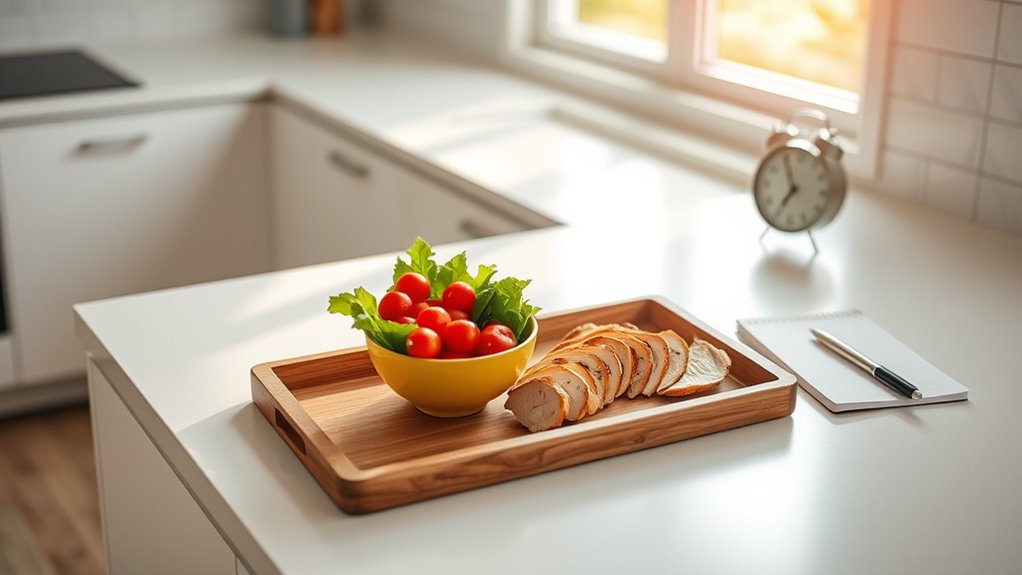
Your weekly schedule plays a crucial role in determining how complex your meals can be. When your schedule is flexible, you can plan more elaborate, nutritionally rich dishes ahead of time. Conversely, busier weeks call for simpler meals that save time and reduce stress. To adapt effectively:
- Prepare meals in advance during free weeks, using batch cooking and leftovers.
- Opt for quick, straightforward recipes during busy periods to avoid last-minute decision fatigue.
- Limit the number of ingredients in your meals when time is tight to ensure faster preparation.
- Focus on nutrient-dense options that require minimal effort but meet your dietary needs.
- Research shows that meal frequency, rather than timing or complexity, has a stronger impact on long-term weight change main factual point.
Adjusting meal complexity helps you stay consistent with your goals without feeling overwhelmed by your schedule.
Introducing New Recipes Gradually for Engagement
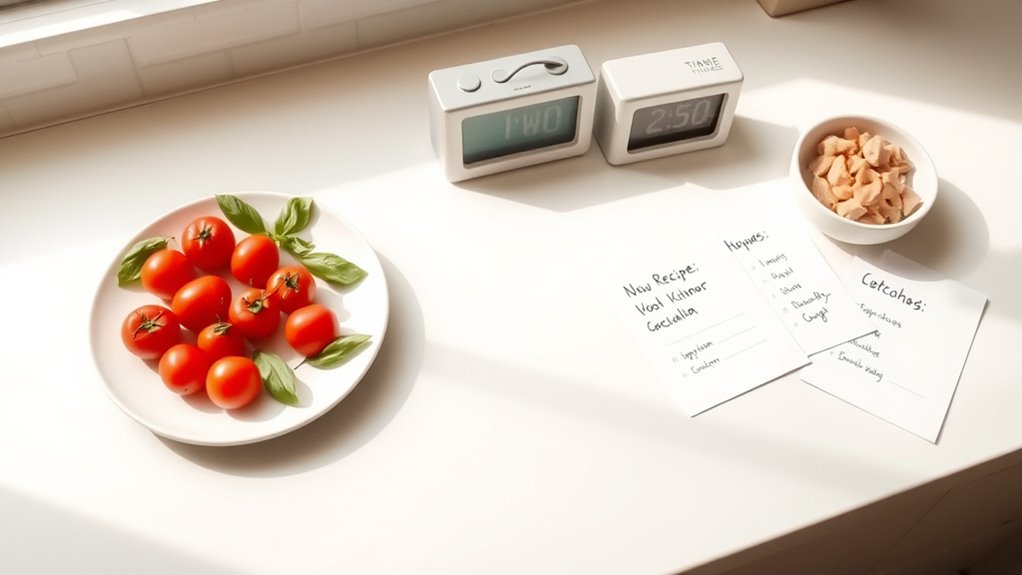
Introducing new recipes gradually can boost your meal planning success by making changes feel manageable. When you introduce one new dish each week, you reduce overwhelm and keep routines stable. Pairing unfamiliar recipes with familiar ones helps ease acceptance and builds confidence in trying new ingredients. Mixing in new flavors slowly allows you to assess how everyone reacts and prevents wasted ingredients if a recipe isn’t well-received. Gathering feedback after each try guides future choices, making your meal plan adaptable. This incremental approach diversifies your meals, boosting nutrient variety and preventing mealtime fatigue. Plus, it encourages experimentation with healthier options and improves your cooking skills over time. Using tools like meal planning apps or grocery lists keeps the process organized and efficient. Research shows that gradual changes in meal routines can lead to more sustainable eating habits and greater enjoyment of diverse cuisines.
Using Substitutions and Mild Variations to Keep Meals Interesting
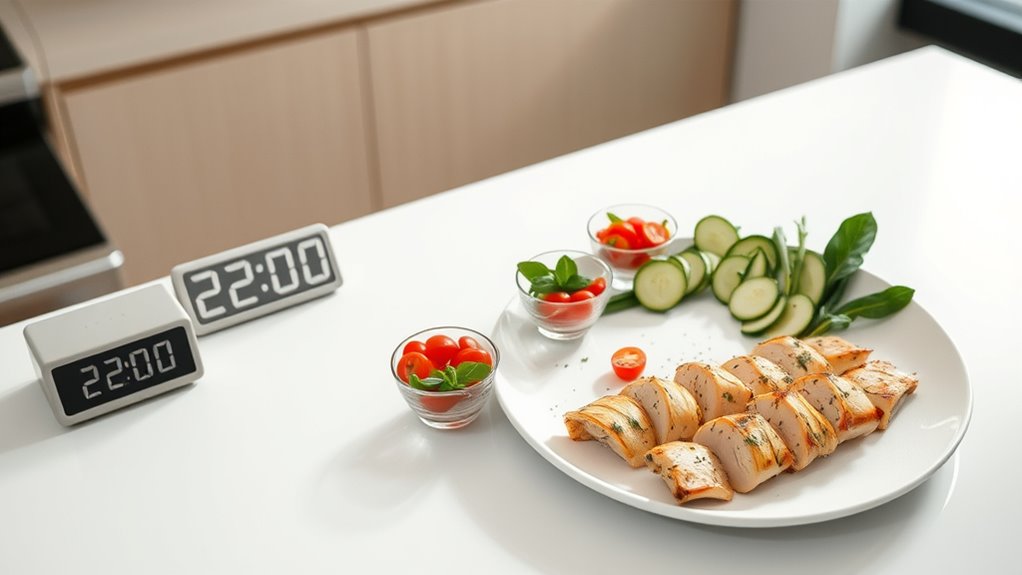
Using substitutions and mild variations is an effective way to keep meals interesting and prevent boredom. By swapping ingredients or adjusting flavors, you can enjoy diverse dishes with minimal effort. Try these strategies:
- Change herbs, spices, or oils to vary the flavor profile without adding extra ingredients.
- Rotate proteins like chicken or beans to introduce different textures and tastes.
- Incorporate various grains such as quinoa or millet for nutritional and textural diversity.
- Experiment with different cooking methods—baking, grilling, or sautéing—to alter textures and enhance flavors.
This approach also helps reduce food waste by utilizing ingredients you already have. These simple tweaks allow you to refresh your meals regularly, making meal prep more engaging while maintaining simplicity. It’s a practical way to enjoy variety without complicating your minimalist approach.
Managing Shopping and Storage for Efficient Meal Prep
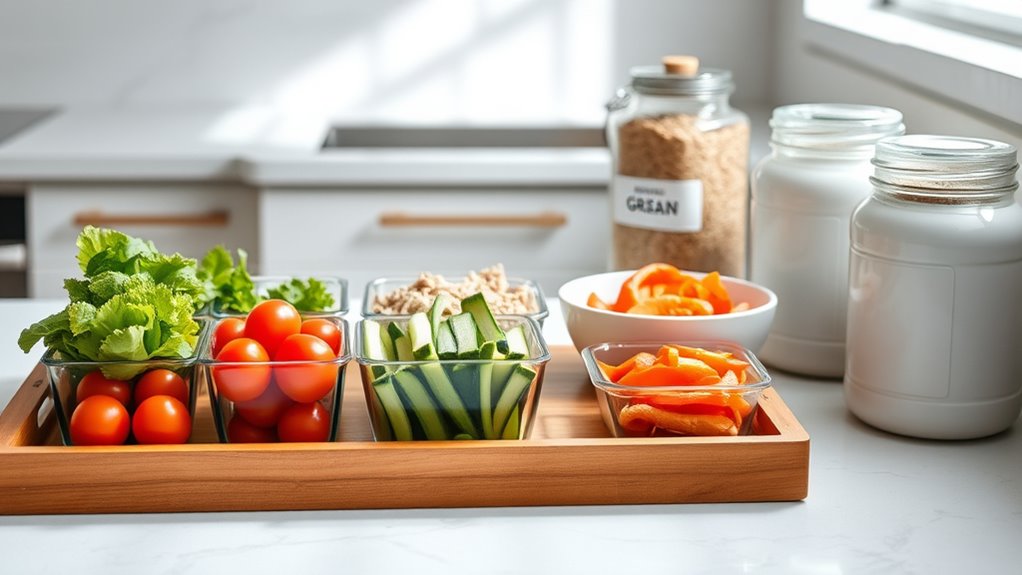
To make meal prep more efficient, you should create focused grocery lists based on your planned meals and current pantry stock. Organizing your storage with designated spots and labeling items helps prevent spoilage and saves time during cooking. Freezing meal components in meal-sized portions guarantees you always have quick, fresh ingredients ready to go. Proper storage techniques also play a crucial role in maintaining the quality of your frozen foods and reducing waste over time.
Streamlining Grocery Lists
Streamlining your grocery list starts with prioritizing ingredients that are versatile, in-season, and easy to find. This simplifies shopping and reduces waste. Focus on these key strategies:
- List ingredients by store section to save time and avoid backtracking.
- Consolidate similar items, like multiple types of limes, into one entry to prevent duplicates.
- Stick to staple ingredients that work across multiple meals, minimizing the number of unique items.
- Use digital tools or apps to clip recipes and generate organized grocery lists, making shopping more efficient.
Optimizing Pantry Storage
Organizing your pantry effectively can considerably boost your meal prep efficiency and reduce clutter. Start by categorizing items—grains, canned goods, spices, snacks, and baking supplies—for quick access. Use clear, labeled containers to improve visibility and cut down search time during cooking. Place frequently used ingredients at eye level or within easy reach to streamline dinner prep. Incorporate adjustable shelves or modular units to maximize vertical space, accommodating different item sizes. Create separate zones for perishables and non-perishables to prevent spoilage and cross-contamination. Store dry goods in airtight containers to maintain freshness and ward off pests. Regularly rotate stock using the FIFO method, monitor expiration dates, and keep the environment cool and dry. These strategies ensure your pantry stays organized, accessible, and efficient for minimalist dinner planning.
Freezing Meal Components
Efficient meal prep begins with smart shopping and storage strategies for freezing components. To maximize your efforts, consider these tips:
- Buy in bulk during sales or in-season, then portion and freeze to save money.
- Use airtight containers or freezer bags to prevent freezer burn and keep flavors fresh.
- Label everything with contents and dates to track freshness and avoid food waste.
- Consider flash freezing individual parts before combining to maintain texture and prevent clumping.
- Properly organizing your freezer with grouped similar ingredients can significantly speed up your meal assembly process and reduce the time spent searching for items.
Organizing your freezer with grouped similar ingredients makes it easier to find what you need. Planning your shopping list around items that freeze well helps you use ingredients fully and prevents spoilage. These simple steps streamline your meal prep and keep your kitchen efficient.
Maintaining Flexibility and Reviewing the Plan for Sustainability
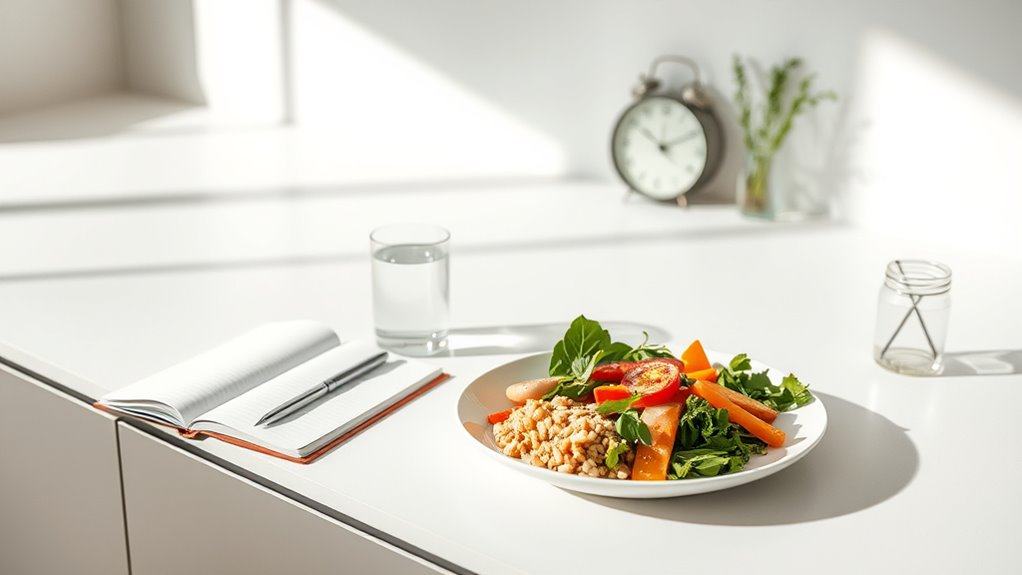
To maintain flexibility and guarantee your meal plan stays sustainable, it’s essential to review and adjust regularly. Check which meals you’ve made and what ingredients are still on hand, then update your plan accordingly. Keep notes on leftovers and repurpose ingredients to prevent waste. Before your next grocery run, review your pantry and fridge to avoid buying duplicates. Be open to shifting meals or recipes based on changing tastes or schedules—flexibility keeps your plan manageable and enjoyable. Incorporate leftovers or frozen portions for spontaneous meals, reducing stress and saving time. Regular reviews help you identify what works and what doesn’t, ensuring your approach remains simple, efficient, and adaptable. This ongoing process supports healthy eating habits while keeping your meal planning sustainable long-term. Consistent review is key to adapting your plan to your evolving needs and preferences.
Frequently Asked Questions
How Can I Adapt Minimalist Meal Planning for Dietary Restrictions?
To adapt meal planning for dietary restrictions, first identify all your specific needs, like gluten or lactose intolerance, and ethical choices such as veganism. Then, choose versatile, whole foods that meet these restrictions, like gluten-free grains or plant-based proteins. Batch cook and prep ahead to save time, and keep your meals flexible by swapping ingredients. This approach helps you stay efficient, safe, and satisfied with your personalized, restriction-friendly meals.
What Are the Best Tools for Tracking My Meal Plans?
Think of tracking your meal plans as tuning a musical instrument—you want everything to be just right. Apps like MyFitnessPal and Cronometer act as your personal symphony conductors, helping you stay on beat with calories and macros. For collaboration, AnyList makes grocery planning a team effort. These tools keep your dietary goals in harmony, ensuring your meals are as balanced and satisfying as a well-composed melody.
How Do I Handle Unexpected Schedule Changes or Emergencies?
When unexpected schedule changes or emergencies happen, you should stay flexible. Keep a list of quick recipes and ready-to-assemble meal components, like pre-cut veggies and pre-cooked proteins. Stock your pantry with essentials and emergency supplies. Use meal planning apps to adapt plans easily, and develop backup options. Building resilience through local food networks and urban agriculture also helps guarantee you always have nutritious options, no matter the situation.
How Often Should I Update or Revise My Meal Rotation?
Imagine your meal plan as a garden that needs tending. You should review and refresh it every three months, like seasonal pruning, to keep variety and freshness alive. If your health, schedule, or supplies shift, update more frequently—monthly if needed. Regularly checking your garden guarantees your meals stay nutritious, satisfying, and aligned with your lifestyle, preventing stagnation and nourishing your well-being over time.
What Are Quick Tips for Introducing New Meals Without Complexity?
When introducing new meals, keep it simple and gradual. Mix new ingredients with familiar ones to ease acceptance. Use versatile, pre-prepped ingredients like frozen vegetables or pre-cooked proteins to cut down prep time. Opt for one-pot or sheet-pan dishes for quick cleanup. Stick to dishes with gentle flavors and repeat them often to build confidence. Flexibility is key—adjust recipes based on what’s available and preferred, making the process stress-free.
Conclusion
By dedicating just two hours to plan 14 dinners, you can reduce weekly meal prep time by up to 50%. Staying flexible with your menu and incorporating pantry staples keeps things simple and enjoyable. Remember, over 60% of busy households find that a streamlined meal plan reduces stress and saves money. With these strategies, you’ll enjoy variety without the decision fatigue, making dinner planning effortless and sustainable for the long run.
I’m Theodore, and I love tiny houses. In fact, I’m the author of Tiny House 43, a book about tiny houses that are also tree houses. I think they’re magical places where imaginations can run wild and adventures are just waiting to happen.
While tree houses are often associated with childhood, they can be the perfect adult retreat. They offer a cozy space to relax and unwind, surrounded by nature. And since they’re typically built on stilts or raised platforms, they offer stunning views that traditional homes simply can’t match.
If you’re looking for a unique and romantic getaway, a tree house tiny house might just be the perfect option.










